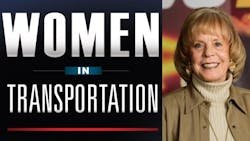Gayle Robertson began her career in the high-tech world of Silicon Valley. She worked for IBM, with a consulting firm, and eventually ended up in sales management. She initially didn’t know anything about trucking or the transportation industry, but that didn’t stop her from jumping right in.
When Robertson met her husband Jerry, the two moved to Tennessee, bought a tractor-trailer, and started an over-the-road trucking company. While running their trucking operation, the Robertsons simultaneously developed an Internet-based fleet management/trucking dispatch software business, which is now known as BOLT System.
Robertson and her husband began their trucking business in 2001 with three trucks. The business then grew to five trucks, and then to 15 at its largest when it included some leased trucks and owner-operators. They sold the profitable trucking business in 2006 to focus on BOLT, which had its first two customers in 2004. By 2007-2008, the Robertsons were solely focused on BOLT.
Robertson referred to her initial launch into trucking as challenging. She went from being a California native, having her own reputation, and being well known as businesswoman.
“It’s been exciting. It truly has been,” Robertson said of her career in trucking. “What had really been a challenge in a lot of ways, initially, was that I was used to being very successful in the California high-tech market—and then we moved to a different geographical market and a completely different industry where there weren’t many women in management. So there were a lot of challenges along that line.”
It also took her time to adapt to the general workings of the industry. “Transportation is such a misleading industry,” Roberston said. “It looks so simple from the outside. Too many people get into it thinking it’s so easy to succeed because all you do is haul goods from one place to the next. But it is such a complex business model. You have to watch every single penny that so many people just don’t make it. High tech looks very complicated from the outside, but it’s not; it’s really very simple in comparison to trucking.”
Robertson’s husband has his CDL, and she would join him on long-haul trips to help him find addresses and load locations, including blind side dock maneuvers. Those were the days before OBCs and graphical routing applications. Though she wasn’t driving the truck, Robertson noted that those trips with her husband were enough to get an insider’s view of the industry.
“It gives you a perspective of what the drivers go through because it’s not easy out there,” she explained. “It makes a big difference now with the ELDs and all the interactions and integrations. A huge percentage of time when a company goes through and first installs an OBC or ELD, the drivers really fight it because they feel like it’s Big Brother. But after a while, they just would not want to go out in a truck without it because it helps so much.”
And that insider experience is what helped the Robertsons develop their own fleet management software.
“When you see what the docks are like and what the delivery points are like and all that’s necessary for an operation to work correctly, it has given us a real insight for what’s needed to work with BOLT. It makes you realize how flexible a system needs to be,” Robertson emphasized.
Part of what keeps Robertson excited in her work is the ever-changing element that industry veterans have grown to know and love.
“It is constantly changing, and it doesn’t get boring,” she said. “It’s a challenge to stay on top of the new technology as well as trying to stay ahead of the competition. We aren’t the biggest, but we are probably the most flexible in terms of what we can do.”
And even as a woman who found it challenging to adapt initially, Robertson encourages more women to get into trucking and logistics, especially because men still outnumber women in the transportation world.
“People are looking at the numbers, and they want more women in management since women tend to be more flexible than men, I think,” Robertson explained. “You need that flexibility and intuitive nature that women can have.”
“There’s just a whole lot of opportunity for women in logistics, management and operations—and as drivers, too,” she added. “There are hardly any women as drivers, and that’s scary in general because the driver pool is starting to diminish.”
About the Author

Cristina Commendatore
Cristina Commendatore is a past FleetOwner editor-in-chief. She wrote for the publication from 2015 to 2023.
